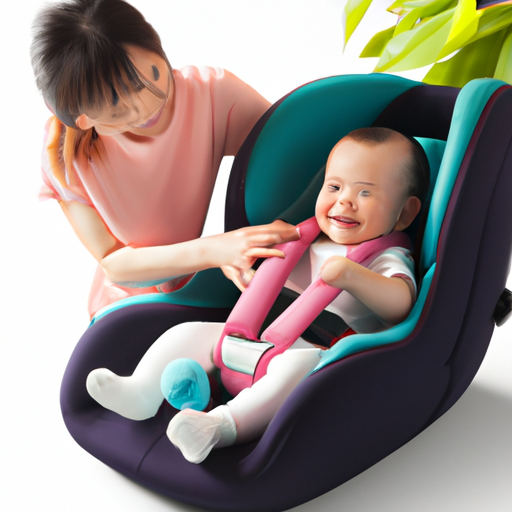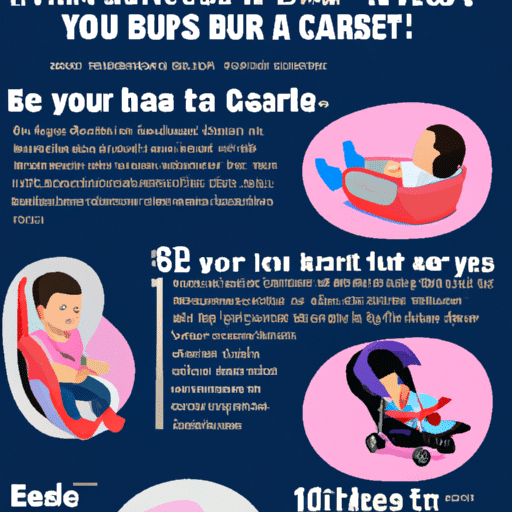When it comes to carrying a baby car seat, it’s important to do so with ease and comfort for both you and your little one. Whether you’re a new parent or simply looking for some tips on how to navigate the world of baby gear, this article will provide you with essential guidance on the best ways to carry a baby car seat, ensuring convenience and safety every step of the way.
Choosing the Right Baby Car Seat
When it comes to choosing the right baby car seat, there are a few important factors to consider. First and foremost, you should take into account your baby’s age and weight. Different car seats are designed for different stages of a child’s development, so it’s essential to choose one that is appropriate for your baby’s specific needs.
Another crucial aspect to consider is safety certification. Before purchasing a baby car seat, make sure it meets all safety standards and has been certified by relevant organizations. Look for labels or markings that indicate compliance with safety regulations to ensure that you are providing the best protection for your little one.
Considering the weight of the car seat is also important. While you may be focused on the weight of your baby, it’s worth noting that car seats vary in weight as well. For ease of use and portability, you may want to opt for a car seat that is not too heavy, especially if you anticipate frequently carrying it with you.
Understanding the Anatomy of a Baby Car Seat
To ensure that you are using your baby car seat correctly and safely, it’s essential to understand its anatomy. Familiarizing yourself with the various components will make it easier for you to install and maneuver the car seat.
Start by identifying the handle. The handle is what you will hold onto when carrying the car seat. It’s usually located at the top, allowing you to lift and transport the seat with ease.
Next, locate the release button. This button is typically found on the side or base of the car seat and is used to detach the seat from its base or attachments. Knowing where the release button is will come in handy when you need to remove the car seat from the car or a stroller frame.
Check the base and attachments of the car seat. The base is the part that remains securely fastened inside the vehicle, while the attachments are used to connect the car seat to the base or a stroller frame. Understanding how these components fit together will help you install and uninstall the car seat correctly.
Lastly, familiarize yourself with the straps and buckles. These are essential for securing your baby in the car seat. Make sure you know how to adjust the straps and buckle them properly to ensure that your baby is secure and comfortable during the car journey.

Preparing for Carrying the Baby Car Seat
Before you set off, there are a few steps you should take to prepare for carrying the baby car seat. Start by removing any additional accessories that may have been attached to the seat. While accessories can be convenient, they can add unnecessary weight and bulkiness, making it more challenging to carry the seat comfortably.
Next, secure the safety harness. Ensure that the harness is properly fastened and adjusted to fit your baby snugly. Double-check that all the buckles are securely latched and that there are no twists or tangles in the straps.
Before you place the car seat in your vehicle, take the time to ensure that it is properly installed. Refer to the manufacturer’s instructions or consult with a certified car seat technician if needed. A properly installed car seat is crucial for your baby’s safety in the event of a collision.
Lastly, before you pick up the car seat, double-check for any loose or detached parts. Ensure that all the components of the car seat are securely in place, including the handle, base, and attachments. It’s better to be safe than sorry, so take a few seconds to give everything a quick once-over.
Using the Two-Hand Method
The two-hand method is one of the most commonly used techniques for carrying a baby car seat. To use this method effectively, follow these steps:
-
Stand behind the car seat with your feet shoulder-width apart. This position will provide you with a stable base of support.
-
Bend your knees and engage your core muscles. This will help you maintain good posture and prevent unnecessary strain on your back.
-
Grasp the handle of the car seat with both hands. Ensure that your grip is firm but comfortable.
-
Lift the car seat close to your body. Use your legs and core muscles to generate the lifting force, rather than relying solely on your arms.
Remember, when using the two-hand method, it’s essential to maintain a balanced and controlled grip on the car seat. By distributing the weight evenly between both hands, you can minimize the risk of strain or discomfort.

Using the One-Arm Method
The one-arm method is a useful technique when you need to carry the baby car seat while also having one arm free for other tasks. Here’s how to use the one-arm method correctly:
-
Position yourself correctly in front of the car seat. Stand with your feet shoulder-width apart and your knees slightly bent. This stance will provide you with a stable base of support.
-
Slide your preferred arm through the handle of the car seat. Make sure your hand is positioned securely around the handle, and your forearm is resting against the side of the car seat.
-
Adjust your grip for balance. Use your arm and hand to stabilize the car seat and prevent it from tilting or shifting.
-
Maintain a close hold on the car seat as you lift it. Keep your arm close to your body, and use controlled movements to prevent strain or discomfort.
When using the one-arm method, it’s essential to listen to your body. If you feel any discomfort or strain, take a break and reassess your carrying position.
Using a Stroller Frame or Travel System
Using a stroller frame or travel system can make it easier to transport your baby and their car seat. When using these accessories, it’s crucial to follow these steps:
-
Choose a compatible stroller frame or travel system that is designed to accommodate your specific car seat model. Consult the user manual or contact the manufacturer to ensure compatibility.
-
Securely attach the car seat to the frame or travel system according to the manufacturer’s instructions. Double-check that the seat is safely fastened and connected before proceeding.
-
Adjust the handle and brakes on the stroller for your comfort and convenience. Ensure that the handle is at a suitable height for pushing and that the brakes are engaged to prevent any unwanted movement.
-
Practice maneuvering with the stroller to familiarize yourself with its operation. Take it for a test drive around your home or yard before venturing out into more crowded or challenging environments.
Using a stroller frame or travel system can provide added convenience and ease when transporting your baby. However, always remain vigilant and maintain control over the stroller, especially on uneven surfaces or in crowded spaces.

Avoiding Common Mistakes
To ensure the safety of your baby and the longevity of your car seat, it’s important to avoid some common mistakes that parents often make. By being aware of these pitfalls, you can minimize risks and prolong the life of your car seat:
-
Avoid carrying the car seat with your child inside. While it may seem more convenient to keep your baby in the car seat while you move them, it’s safer to take them out of the seat before lifting or carrying it. This reduces the risk of injury to your baby and prevents strain on your body.
-
Do not place the car seat on unstable surfaces. Always ensure that the surface you rest the car seat on is stable and secure. Avoid placing it on elevated surfaces such as tables or countertops.
-
Do not carry the car seat by the canopy or straps. The canopy and straps of a car seat are not designed to support the weight of the seat. Always use the designated handle when carrying the car seat to ensure stability and safety.
-
Avoid placing other objects on top of the car seat. It’s tempting to use the car seat as a convenient place to store items, but this can compromise its safety and integrity. Keep the car seat clear of any additional items to ensure proper function and protection.
By being mindful of these common mistakes, you can ensure the longevity and safety of your baby car seat.
Tips for Carrying the Car Seat Safely
Carrying a baby car seat can be challenging, especially if it’s heavy or if you need to transport it for long periods. To help make the task easier and safer, consider the following tips:
-
Use a car seat with a lightweight design. If possible, opt for a car seat that is lightweight and easy to handle. This will minimize strain on your body and make carrying the seat more comfortable.
-
Engage your core and maintain good posture. Before lifting the car seat, engage your core muscles and maintain a straight back. This will help distribute the weight evenly and reduce strain on your back and shoulders.
-
Take frequent breaks if needed. If you find yourself becoming fatigued or uncomfortable, take short breaks to rest and rejuvenate. Listen to your body’s signals and pace yourself accordingly.
-
Ask for assistance if the car seat is too heavy. Don’t hesitate to ask for help if the car seat is too heavy for you to comfortably carry on your own. Seek the assistance of a family member, friend, or even a helpful stranger if needed.
By implementing these safety tips, you can ensure that carrying the car seat remains a manageable task without compromising your well-being or that of your baby.

Ensuring Comfort and Safety for Your Baby
While carrying the car seat safely is essential, it’s equally important to ensure your baby’s comfort and safety within the seat itself. Consider the following tips to provide a comfortable and secure environment for your little one:
-
Provide additional cushioning for your baby. If your car seat allows for it, you can add extra padding or cushioning to ensure your baby’s comfort. Just make sure that any additional padding does not interfere with the proper functioning of the seat or compromise its safety features.
-
Adjust the straps for a snug fit. Ensure that the straps of the car seat are properly adjusted to fit your baby snugly. This will prevent excessive movement and keep your baby securely in place during the car journey.
-
Avoid prolonged use of the car seat outside the car. While the car seat may be convenient for carrying your baby around, it’s important to avoid prolonged use of the seat outside of the car. Your baby needs freedom of movement and opportunities for exploration to support their development.
-
Regularly check for recalls or safety updates. Stay informed about any recalls or safety updates related to your specific car seat model. Check the manufacturer’s website regularly and register your car seat to receive notifications in case there are any safety concerns.
By prioritizing your baby’s comfort and safety, you can create a nurturing environment, both inside and outside the car.
Practice Makes Perfect
Like any skill, carrying a baby car seat requires practice and familiarity. By dedicating some time to practice, you can refine your technique, build strength, and feel more confident in your ability to maneuver the car seat. Consider the following tips when practicing:
-
Practice carrying the car seat with an empty seat. Start by practicing with an empty car seat. This will allow you to focus on your technique without the added weight of your baby.
-
Practice in different situations and environments. As your confidence grows, challenge yourself by practicing in various situations and environments. This will help you adapt and feel comfortable in different scenarios.
-
Build your strength gradually. If you find the car seat heavy or challenging to carry, focus on gradually building your strength and stamina. Start with shorter durations and gradually increase the time spent carrying the seat.
-
Seek professional guidance if necessary. If you are unsure about your technique or have specific concerns, don’t hesitate to seek professional guidance. Certified car seat technicians can provide valuable advice and ensure that you are using the car seat correctly.
Remember, practice is key to mastering any skill. The more you practice carrying the car seat, the more comfortable and confident you will become.
In conclusion, carrying a baby car seat requires careful consideration, practice, and a focus on safety. By choosing the right car seat, understanding its anatomy, and using proper carrying techniques, you can ensure the comfort and safety of your baby. Remember to prioritize your own well-being as well, engaging your core, and taking breaks when needed. With practice and proper knowledge, you can confidently carry your baby car seat and navigate the world with ease.






